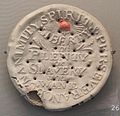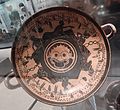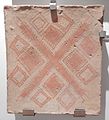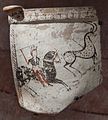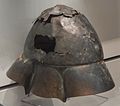User:BabelStone/Ashmolean Museum
Jump to navigation
Jump to search
Ashmolean Museum, Oxford
[edit]-
Inscription in in Eteocypriot (Cypriot syllabary), cica 500-300 BC, probably from Amathous. Donated to the Ashmolean Museum by Prof. J. L. Myres in 1895.
-
The 'Wittenham Shield', Bronze Age, circa 1400-700 BC. Found in the River Thames at Long Wittenham, Oxfordshire. The shield shows damage by a socketed spearhead.
-
East Greek plate in the 'Wild Goat' style, showing a sphinx with geometric and floral motifs above a zone of petals. From Siana, Rhodes, 600-570 BC.
-
East Greek oinochoe (wine jug) in the 'Wild Goat' style, with animal friezes featuring wild goats combined with floral and geometric motifs. 620-570 BC. Gift of John Beazley. AN1966 1021.
-
Athenian black-figure plate depicting Heracles and Apollo fighting over the Keryneian hind, a golden deer sacred to the goddess Artemis. 575-525 BC. AN1934.333.
-
Terracotta statuette of Aphrodite. Smyrna, Turkey. 200 - 1 BC. AN1911.23.
-
The Odda Stone. Late Anglo-Saxon inscription in Latin dated 1056 on a limestone block, found in 1675 near Deerhurst, Gloucestershire. The inscription reads, in translation, "Earl Odda ordered this royal church to be built and dedicated in honour of the Holy Trinity for the soul of his brother Ælfric which was taken up from this place. And Ealdred was the bishop who dedicated the same on the second of the Ides of April and in the fourteenth year of the reign of Edward, King of the English [12 April 1056]." AN1896-1908 M 300.
-
Granite rune stone, donated to the Ashmolean Museum by John Robinson on behalf of King Karl XI of Sweden in 1687. The runic inscription reads, in translation: "Lidsmod had this stone carved in memory of Julbjörn [his] father." AN1687.1
-
Carved wooden archangel, originally part of the decorated roof of St John's Chapel in St Mary's Church in Ewelme, Oxfordshire. The figure would originally have had four or six wings, and would have been painted. Circa 1450. AN1957.180.
-
Clay tile from Eynsham Abbey, Oxfordshire. 1250-1500. AN1887.3196.
-
Wooden statue of Guanyin (Avolekitesvara) with gesso, polychrome and gilding. Northern Song (960-1127), from Northern Shanxi, possibly Wutai Shan. EA1999.96.
-
Pieces from the Cuerdale Hoard, a Viking hoard of more than 8,500 pieces of silver jewellery, ingots and coins found in 1840. Most of the hoard is held at the British Museum in London, but this part is held at the Ahmolean Museum in Oxford.
-
Reliquary casket of Saint Thomas Becket, depicting his murder. Gilt copper alloy, champlevé enamel and wood. Circa 1200, Limoges, France. AN2008.36.
-
Ceramic wall tile depicting the Resurrection of Christ. Circa 1450. Great Malvern, Worcestershire. AN1967.672.
-
Carved wooden panel decorated with oak and beech trees. 1600-1650. Ashridge Park, Hertfordshire. Originally part of a larger carving, this piece was cut and reused as a door during the 19th century. AN1959.167.
-
Two Anglo-Saxon composite jewelled disc brooches, made from gold, glass, garnet and shell. 600-700. Sarre and Monkton, Kent. AN1934.202 and AN1972.1401.
-
Biscuit commemorating the abolition of slavery, inscribed "Liberty and Plenty or Slavery and Want". 1834. England. AN1938.15.
-
Greek grave monument, depicting the deceased Archippus accompanied by two servants. Smyrna (?). 3rd to 2nd century BC. Ex Cook Collection. AN1947.271.
-
Replica of a bronze statue of a man commonly identified as Zeus brandishing a thunderbolt. The original was found in two parts off Cape Artemisium on the island of Euboea, Greece in 1926 and 1928, near a 2nd century BC shipwreck. Circa 470 BC. CC B.72.A.
-
Athenian black-figure pottery kylix (drinking cup). 550-501 BC. Bomford bequest. AN1974.344. The foot of the cup is in the form of a phallus and testicles.
-
Athenian black-figure pottery kylix (drinking cup). 550-501 BC. Bomford bequest. AN1974.344. The foot of the cup is in the form of a phallus and testicles.
-
The Parian Marble, the oldest surviving example of a Greek chronological table, compiled on the island of Paros in 264/263 BC, listing important events going back to 1581/1580 BC. This is one of three known fragments of the inscription, which was acquired by Oxford University in 1667. A second fragment was lost in London during the Civil War; a third fragment was found on paros in 1897.
-
Painted terracotta tile from Baba Jan, Luristan, Iran. 800-700 BC. One of 176 tiles found in a ceremonial building next to a fort, the ceiling of which had collapsed following a fire in about 700 BC. The pattern may be inspired by textiles.
-
Painted terracotta tile from Baba Jan, Luristan, Iran. 800-700 BC. One of 176 tiles found in a ceremonial building next to a fort, the ceiling of which had collapsed following a fire in about 700 BC. The pattern may be inspired by textiles.
-
Painted terracotta tile from Baba Jan, Luristan, Iran. 800-700 BC. One of 176 tiles found in a ceremonial building next to a fort, the ceiling of which had collapsed following a fire in about 700 BC. The pattern may be inspired by textiles.
-
Painted terracotta tile from Baba Jan, Luristan, Iran. 800-700 BC. One of 176 tiles found in a ceremonial building next to a fort, the ceiling of which had collapsed following a fire in about 700 BC. The pattern may be inspired by textiles.
-
Fragment of a painted ceramic funerary urn showing a hunter and a stag, probably from Phrygia in central Anatolia. 450-330 BC. AN1922.1
-
Boeotian bronze helmet found in the River Tigris in Iraq. Presumed to have been lost by one of Alexander the Great's cavalrymen on campaign in Mesopotamia. Ashmolean Museum, Oxford. AN1977.256.




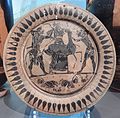

![The Odda Stone. Late Anglo-Saxon inscription in Latin dated 1056 on a limestone block, found in 1675 near Deerhurst, Gloucestershire. The inscription reads, in translation, "Earl Odda ordered this royal church to be built and dedicated in honour of the Holy Trinity for the soul of his brother Ælfric which was taken up from this place. And Ealdred was the bishop who dedicated the same on the second of the Ides of April and in the fourteenth year of the reign of Edward, King of the English [12 April 1056]." AN1896-1908 M 300.](https://upload.wikimedia.org/wikipedia/commons/thumb/1/14/Odda_Stone.jpg/120px-Odda_Stone.jpg)
![Granite rune stone, donated to the Ashmolean Museum by John Robinson on behalf of King Karl XI of Sweden in 1687. The runic inscription reads, in translation: "Lidsmod had this stone carved in memory of Julbjörn [his] father." AN1687.1](https://upload.wikimedia.org/wikipedia/commons/thumb/e/e6/Ashmolean_rune_stone.jpg/56px-Ashmolean_rune_stone.jpg)







